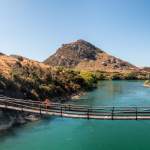
Hold Your Horses!
How do you know if your e-bike has too much horsepower for the trails?
NZ Rules for e-Bike Motor Size
Electric bikes are now such a common sight on the Otago trails that they often outnumber cyclists on standard ‘analogue’ bikes. The boom in the e-bike market means that the trails are more accessible to a wider demographic as riders can enjoy the extra assistance provided by the motor for weekend rides and multi-day trips along Otago’s Great Rides.
However, it’s important to understand that e-bikes are subject to different laws and regulations than non-assisted bikes, especially along designated cycle trails where a maximum power output of 300-watts applies for e-bikes within New Zealand.
The 300-watt (W) power limit is in effect across all five of Otago’s Ngā Haerenga Great Rides for the safety of all trail users and to help maintain the quality of the trails, as more powerful bikes can cause significant damage to the track surface. The photo (right) shows extensive track damage caused by e-motorbikes along the Queenstown Trail.
Riding a bike with too much horsepower can result in infringements or even prosecution. Therefore, it’s important to understand the wattage of your e-bike motor.
So, what legally constitutes an electric bike in NZ, how much assistance can an e-bike give you and what are the laws around riding one?
When is an e-Bike Not an e-Bike?... When it’s a Moped...
The rules and regulations regarding e-bikes (aka power assisted cycles) vary from country to country, but in New Zealand Waka Kotahi | NZ Transport Agency (NZTA) define an e-bike as, “a power assisted cycle that has an auxiliary electric motor with a maximum power output not exceeding 300-watts and is designed to be primarily propelled by the muscular energy of the rider”.
In other words, the bike’s motor can only provide assistance when the rider is pedalling.
Oh, and whilst this might seem obvious, a cycle is defined as a "vehicle that has at least two wheels and that is designed primarily to be propelled by the muscular energy of the rider".

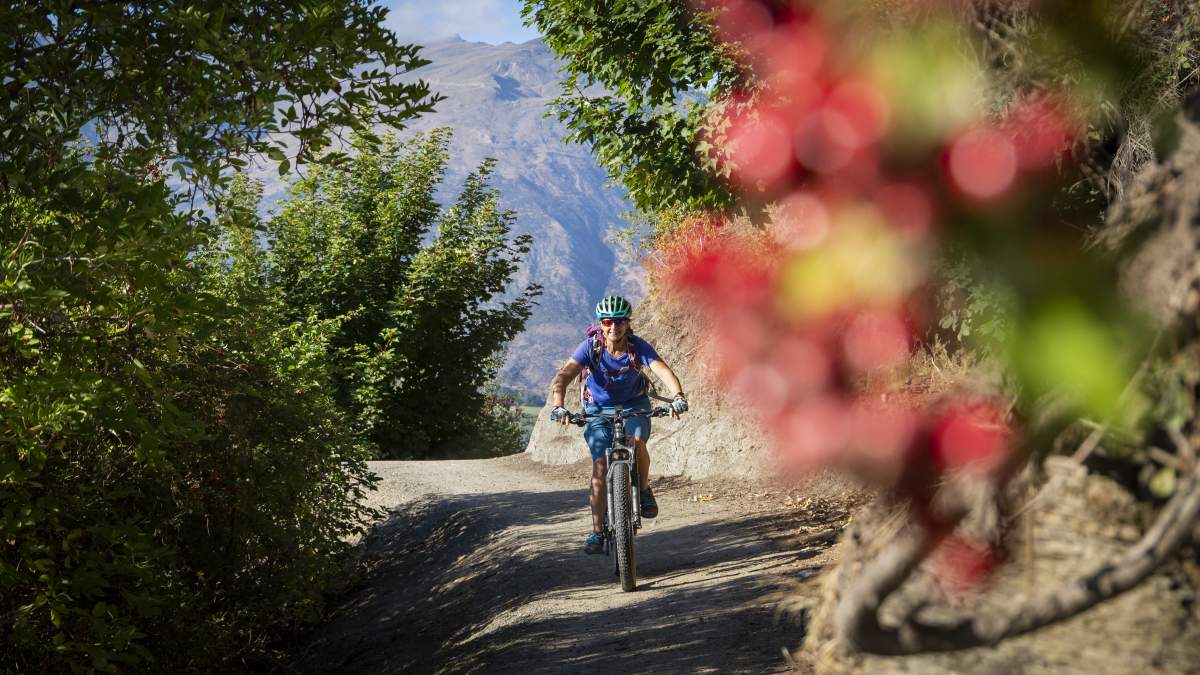
E-bikes of up to 300W are plenty powerful enough for the Otago Cycle Trails. [Photos: Lake Hayes, Queenstown].
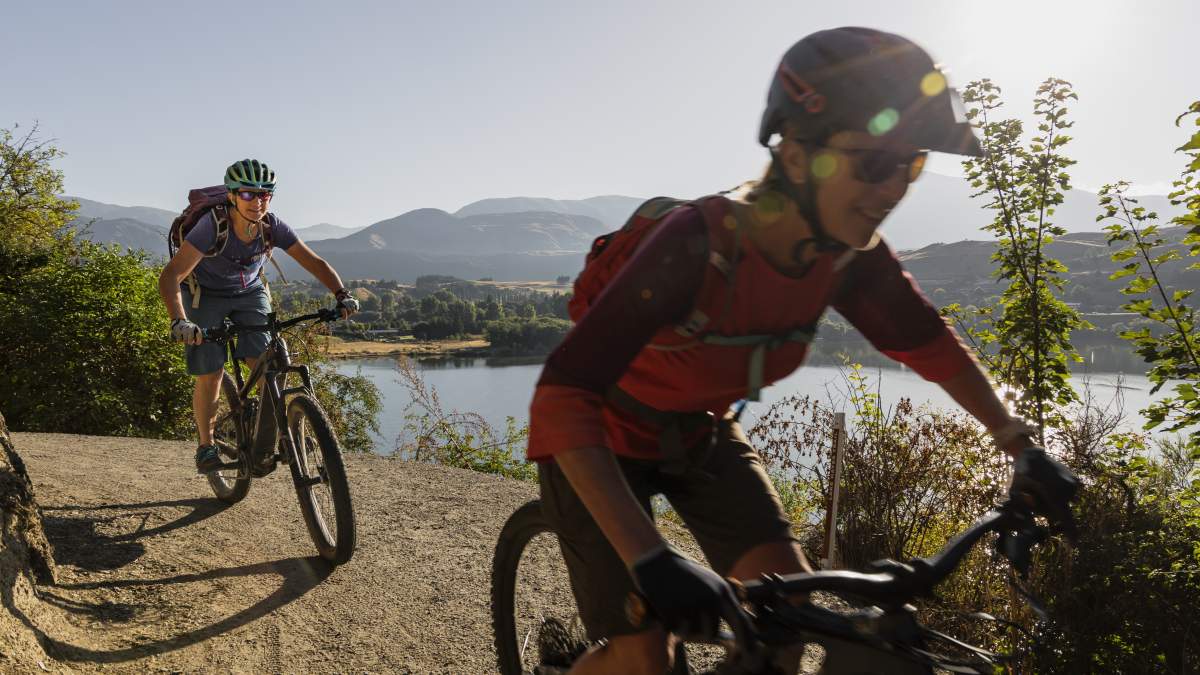
The 300W limit on e-bike motors makes the trails safer for users and causes less damage to the tracks.
Based on these NZTA rules, the following examples are classified as mopeds and are not permitted on the Otago cycle trails. Furthermore, unauthorised use of the trails by mopeds, e-motorbikes or motorbikes can result in infringements or prosecution.
- Cycles with a maximum power output of greater than 300W.
- Cycles fitted with petrol motors.
- Low powered scooters/mopeds.
- Cycles designed primarily to be propelled by a motor and not the muscular energy of the rider (often throttle operated bikes).
It's a legal requirement in NZ that you must always wear a helmet when riding a bike on the road, and your bike must have good brakes. This is also essential when riding on cycle trails. You must also have the correct lights and reflectors for the conditions you are riding in. Whilst not a legal requirement, a bell is highly recommended.
NZTA has some useful further reading about cycling in New Zealand here and the NZ Code for Cycling is also worth reviewing.
What's All This About Watts?
Firstly, a very quick recap of some high school physics…
Watts are a measure of power (named after the 18th century Scottish inventor James Watt), which is the rate at which energy is transferred. In the context of e-bikes, watts refer to the amount of power that the motor can deliver to assist the rider. A higher wattage motor generally means more power, which translates to faster acceleration and better climbing ability.
250-watt motors are the most common wattage for e-bikes. They are relatively low-powered, which makes them efficient in terms of battery consumption, but they offer less assistance on steeper hills or with heavier loads. However, 250W motors are ideal for most of Otago’s Great Rides which are predominantly easy-intermediate graded trails with only moderate climbs.
In terms of horses, a 250-watt e-bike has 0.33 horsepower.
To provide a better understanding of the concept of power in human terms (rather than horses), let’s consider the wattage output of an average cyclist on a standard bicycle.
When pedalling at an ordinary cruising speed - typically around 15 kilometres per hour for the Otago trails - a rider generates approximately 30-watts of power which is roughly equivalent to the energy expended during a brisk walk. Increasing the speed to 30 kilometres per hour introduces more aerodynamic resistance and requires a substantial 220-watts of power, a level that most non-athletes would struggle to maintain. Climbing up a 10 percent grade slightly faster than a walking pace demands 150-watts of effort, enough to leave most riders breathing heavily and working up a good sweat!
In the world of elite cycling, professional Tour de France riders can produce an astonishing 400+ watts of power for an hour, and during the intense final sprint of a race, they can unleash over 1000-watts.
Thankfully, most visitors to the Otago trails are not riding at Grand Tour level and enjoy riding at a more sedate holiday pace compared to the Chris Froome or Greg Lemond’s of this world. So, whilst New Zealand's regulations limit e-bikes to 300-watts on cycle paths, this is more than sufficient for comfortable riding on the scenic Otago trails…. even if it doesn't quite transform us into professional cyclists with uber leg muscles and huge lung capacity.
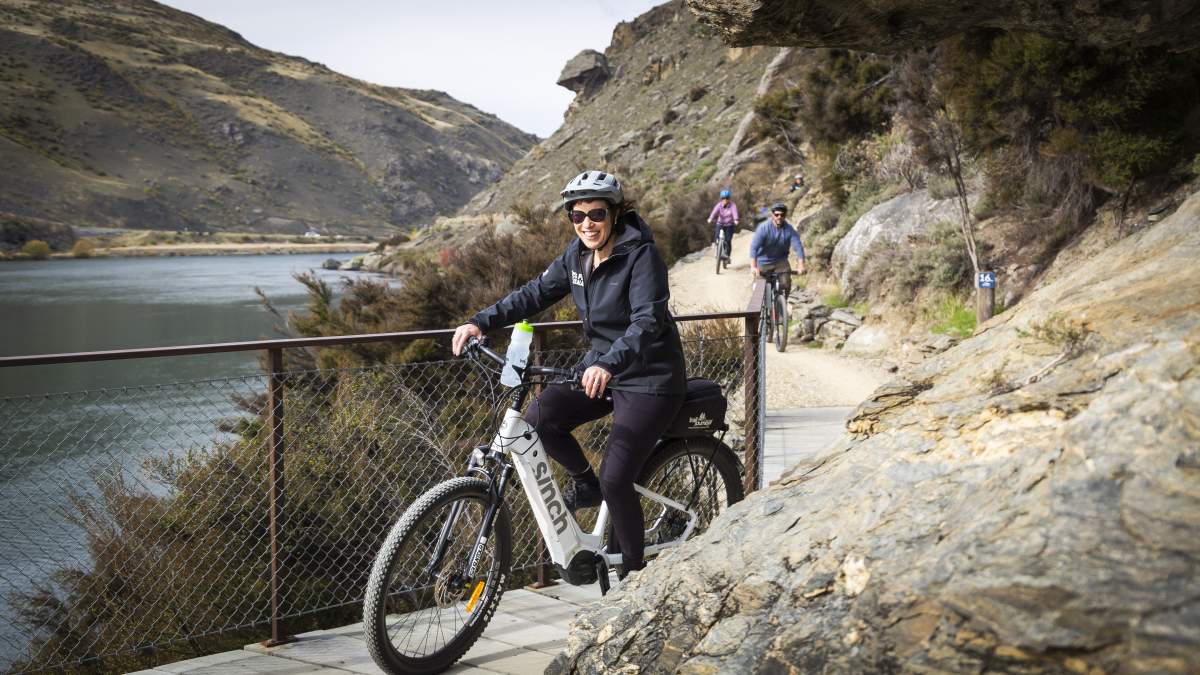
e-Bikes have provided greater access to the Otago Trails. [Photos: Lake Dunstan Trail].
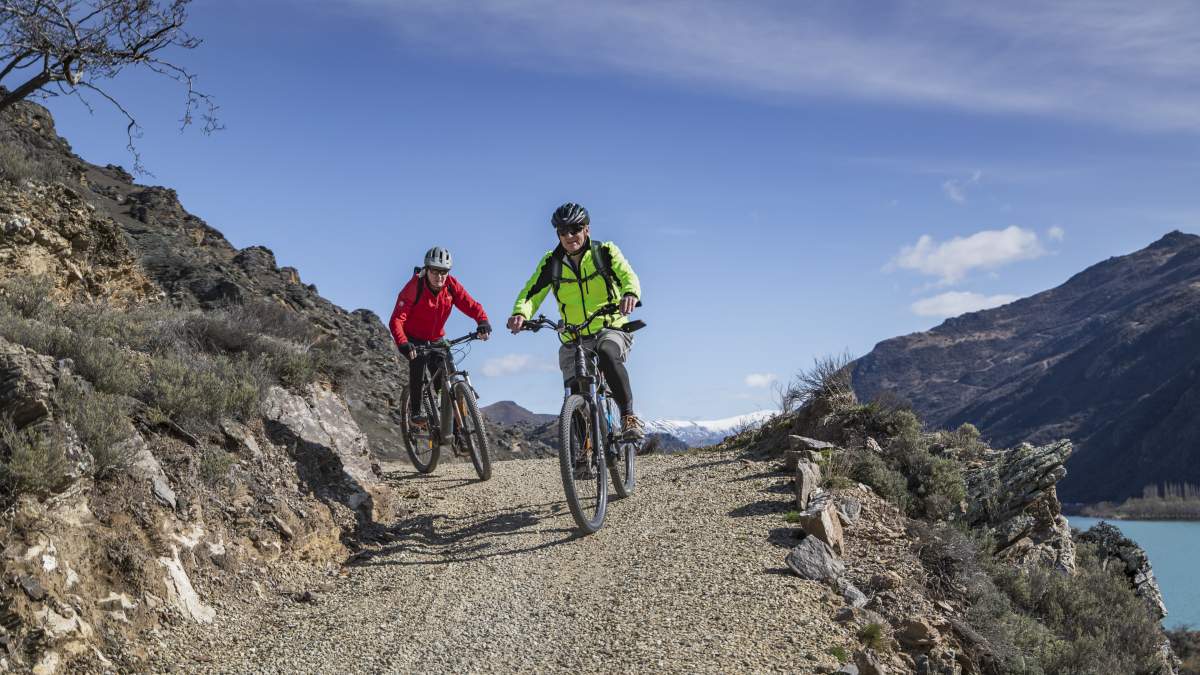
Local tour operators only hire e-bikes which are permitted on the trails and can help you choose the bike best suited to your fitness and ability.
Maximum Power Output vs Continuous Power Output
Keeping up so far?
Sounds simple, doesn’t it? But guess watt? It’s not…
The term "maximum power output" that’s described in NZTA’s regulations can cause confusion as some e-bike motor manufacturers refer to their "maximum input power", which is different i.e. input vs. output. Perhaps this is a cunning marketing ploy as the input power number is always larger than output, creating the impression that the customer is getting a more powerful motor. Obviously, this can cause misunderstandings when determining if the e-bike is permitted on the trails or not.
To further complicate matters, some manufacturers rate their motors based on "continuous power" rather than "maximum power."
It’s well worth doing some research to discover how specific manufacturers have calculated their motor output as not everyone uses the same method to calculate their bike’s rating. Many use the maximum continuous output for the motor – this is the output that the motor can consistently deliver without overheating or breaking.
To help explain this, imagine that you buy an e-bike that’s officially rated at 250-watts under the continuous power rating, but it can reach maximum power outputs of over 500-watts. Would this bike be permitted on the cycle trails? Well, in NZ, no as the maximum output is greater than 300W.
Although in this example the e-bike can peak at higher wattage (500W+), sustaining that level for more than a few seconds is unlikely. Nonetheless, this 250-watt rated bike would not be permitted on NZ cycle trails.
Batteries – Not Watt You Think!
It’s easy to confuse electric bike motor wattage with e-bike battery ratings. Often, you’ll see this referred to as Wh or Watt-hours. Wh is the battery capacity, or to be more specific, how many Watts it can deliver to the motor per hour.
In a nutshell, watt-hours measure amounts of energy for a specific period of time, and watts measure rates of power at a moment in time.
In most cases, electric bike batteries are 300Wh to 500Wh but as battery technology has progressed, 750Wh batteries are becoming more common giving riders much longer range.
NZTA has no restrictions relating to battery size.
Consumer NZ has a great guide to electric bikes, check it out at the link below.
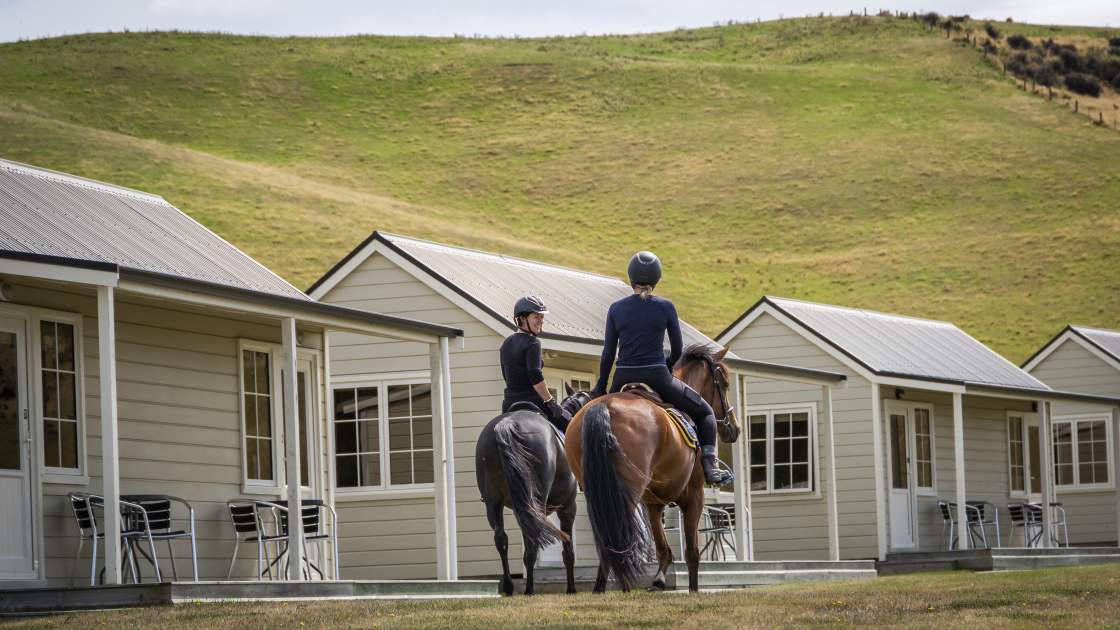
If real "horse" power is your thing, then horse riding is permitted along the Otago Central Rail Trail. But please only ride your steed at walking pace and in single file on the side of the trail. Lead over bridges and through tunnels and please remove dung from the trail!

Related Stories
-

Otago Central Rail Trail Pub Guide
A guide to the pubs along the Otago Central Rail Trail
Read more about Otago Central Rail Trail Pub Guide -

Best Bakeries in Otago
From cinnamon scrolls to cheese rolls - a guide to the best trailside bakeries in Otago.
Read more about Best Bakeries in Otago -

25 Years On Track
The old and the new - celebrating 25 years of the Otago Central Rail Trail
Read more about 25 Years On Track -

Neat Trail Places
An insider's guide to the neatest places along Central Otago's bike trails.
Read more about Neat Trail Places -

Clutha Gold Trail Beginners Guide
A beginners guide to the Clutha Gold Trail
Read more about Clutha Gold Trail Beginners Guide -

Beginners Guide to Queenstown Trails
A beginner's guide to biking the Queenstown Trails
Read more about Beginners Guide to Queenstown Trails -

Beginners Guide to the Otago Central Rail Trail
A beginner's guide to the Otago Central Rail Trail
Read more about Beginners Guide to the Otago Central Rail Trail -

Don't just ride - play bike!
If we play sports, then why don't we "play bike"?
Read more about Don't just ride - play bike!








